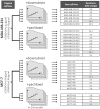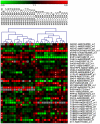Parallel evolution under chemotherapy pressure in 29 breast cancer cell lines results in dissimilar mechanisms of resistance
- PMID: 22319589
- PMCID: PMC3271089
- DOI: 10.1371/journal.pone.0030804
Parallel evolution under chemotherapy pressure in 29 breast cancer cell lines results in dissimilar mechanisms of resistance
Abstract
Background: Developing chemotherapy resistant cell lines can help to identify markers of resistance. Instead of using a panel of highly heterogeneous cell lines, we assumed that truly robust and convergent pattern of resistance can be identified in multiple parallel engineered derivatives of only a few parental cell lines.
Methods: Parallel cell populations were initiated for two breast cancer cell lines (MDA-MB-231 and MCF-7) and these were treated independently for 18 months with doxorubicin or paclitaxel. IC50 values against 4 chemotherapy agents were determined to measure cross-resistance. Chromosomal instability and karyotypic changes were determined by cytogenetics. TaqMan RT-PCR measurements were performed for resistance-candidate genes. Pgp activity was measured by FACS.
Results: All together 16 doxorubicin- and 13 paclitaxel-treated cell lines were developed showing 2-46 fold and 3-28 fold increase in resistance, respectively. The RT-PCR and FACS analyses confirmed changes in tubulin isofom composition, TOP2A and MVP expression and activity of transport pumps (ABCB1, ABCG2). Cytogenetics showed less chromosomes but more structural aberrations in the resistant cells.
Conclusion: We surpassed previous studies by parallel developing a massive number of cell lines to investigate chemoresistance. While the heterogeneity caused evolution of multiple resistant clones with different resistance characteristics, the activation of only a few mechanisms were sufficient in one cell line to achieve resistance.
Conflict of interest statement
Figures





Similar articles
-
cDNA microarray analysis of isogenic paclitaxel- and doxorubicin-resistant breast tumor cell lines reveals distinct drug-specific genetic signatures of resistance.Breast Cancer Res Treat. 2006 Mar;96(1):17-39. doi: 10.1007/s10549-005-9026-6. Epub 2005 Dec 2. Breast Cancer Res Treat. 2006. PMID: 16322897
-
Cross-resistance studies of isogenic drug-resistant breast tumor cell lines support recent clinical evidence suggesting that sensitivity to paclitaxel may be strongly compromised by prior doxorubicin exposure.Breast Cancer Res Treat. 2004 May;85(1):31-51. doi: 10.1023/B:BREA.0000021046.29834.12. Breast Cancer Res Treat. 2004. PMID: 15039596
-
Adipocytes promote breast cancer resistance to chemotherapy, a process amplified by obesity: role of the major vault protein (MVP).Breast Cancer Res. 2019 Jan 17;21(1):7. doi: 10.1186/s13058-018-1088-6. Breast Cancer Res. 2019. PMID: 30654824 Free PMC article.
-
p-Glycoprotein ABCB5 and YB-1 expression plays a role in increased heterogeneity of breast cancer cells: correlations with cell fusion and doxorubicin resistance.BMC Cancer. 2010 Jul 22;10:388. doi: 10.1186/1471-2407-10-388. BMC Cancer. 2010. PMID: 20649952 Free PMC article.
-
Potent killing of paclitaxel- and doxorubicin-resistant breast cancer cells by calphostin C accompanied by cytoplasmic vacuolization.Breast Cancer Res Treat. 2003 Nov;82(2):125-41. doi: 10.1023/B:BREA.0000003969.21267.81. Breast Cancer Res Treat. 2003. PMID: 14692656
Cited by
-
Predicting censored survival data based on the interactions between meta-dimensional omics data in breast cancer.J Biomed Inform. 2015 Aug;56:220-8. doi: 10.1016/j.jbi.2015.05.019. Epub 2015 Jun 3. J Biomed Inform. 2015. PMID: 26048077 Free PMC article.
-
Challenges in the management of advanced, ER-positive, HER2-negative breast cancer.Nat Rev Clin Oncol. 2015 Sep;12(9):541-52. doi: 10.1038/nrclinonc.2015.99. Epub 2015 May 26. Nat Rev Clin Oncol. 2015. PMID: 26011489 Review.
-
Regulatory polymorphisms in β-tubulin IIa are associated with paclitaxel-induced peripheral neuropathy.Clin Cancer Res. 2012 Aug 15;18(16):4441-8. doi: 10.1158/1078-0432.CCR-12-1221. Epub 2012 Jun 20. Clin Cancer Res. 2012. PMID: 22718863 Free PMC article.
-
In vitro Development of Chemotherapy and Targeted Therapy Drug-Resistant Cancer Cell Lines: A Practical Guide with Case Studies.Front Oncol. 2014 Mar 6;4:40. doi: 10.3389/fonc.2014.00040. eCollection 2014. Front Oncol. 2014. PMID: 24639951 Free PMC article.
-
Differential network analysis applied to preoperative breast cancer chemotherapy response.PLoS One. 2013 Dec 9;8(12):e81784. doi: 10.1371/journal.pone.0081784. eCollection 2013. PLoS One. 2013. PMID: 24349128 Free PMC article.
References
-
- Gyorffy B, Surowiak P, Kiesslich O, Denkert C, Schafer R, et al. Gene expression profiling of 30 cancer cell lines predicts resistance towards 11 anticancer drugs at clinically achieved concentrations. Int J Cancer. 2006;118:1699–1712. - PubMed
-
- Wang HM, Mao Y, Zhou N, Hu T, Hsieh TS, et al. ATP-bound topoisomerase II as a target for antitumor drugs. Journal of Biological Chemistry. 2001;276:15990–15995. - PubMed
-
- Lehne G, Morkrid L, den Boer M, Rugstad HE. Diverse effects of P-glycoprotein inhibitory agents on human leukemia cells expressing the multidrug resistance protein (MRP). International Journal of Clinical Pharmacology and Therapeutics. 2000;38:187–195. - PubMed
-
- Kartner N, Riordan JR, Ling V. Cell-Surface P-Glycoprotein Associated with Multidrug Resistance in Mammalian-Cell Lines. Science. 1983;221:1285–1288. - PubMed
-
- Gyorffy B, Serra V, Jurchott K, Abdul-Ghani R, Garber M, et al. Prediction of doxorubicin sensitivity in breast tumors based on gene expression profiles of drug-resistant cell lines correlates with patient survival. Oncogene. 2005;24:7542–7551. - PubMed
Publication types
MeSH terms
Substances
LinkOut - more resources
Full Text Sources
Medical
Miscellaneous

